
Rava Payasam also known as sooji kheer is such a beloved dessert in Indian cuisine, and there are so many delicious varieties of it that bring charm to any festive occasion. Made from sooji, sugar, milk, condensed milk, ghee and nuts, this sweet and creamy dish is enjoyed all over India during big festivals like Onam, Diwali, Ugadi, and Navratri. Learn how to make sooji kheer with step by step pictures.


Rava Payasam
Whether it’s the classic Rava Kheer/ Sooji Payasam, Semiya Payasam made with vermicelli or Pal Payasam with rice, each variety has its own special place in Indian food traditions. The best part about payasam is its versatility, it’s never just one type.
Jump to:
There are so many regional variations, like Coconut Payasam, Moong Dal Payasam, or even Carrot Payasam. It’s always part of a feast, whether served as prasad in temples or enjoyed at family gatherings. From the rich sweetness of kheer to the delicate flavors of rava payasam/ sooji kheer, and phirni, these desserts are a true reflection of India’s rich food culture, filling every occasion with joy and satisfaction.
About Rava Payasam
Rava Payasam has always been a part of my fondest memories, a dish that brings a sense of nostalgia with every spoonful. I still remember those evenings when the whole house would fill with the comforting aroma of Rava Payasam. It was a tradition in our family, especially during Diwali, when my grandmother would lovingly prepare this dish.
The soft, creamy texture of the sooji kheer would melt in our mouths, and we’d eagerly wait for that first spoonful. The magic lay in the perfect balance of sweetness and the richness of sweetened condensed milk that brought it all together.
Why I Love This Recipe – The recipe uses just a few basic ingredients like rava (semolina), milk, sugar, and sweetened condensed milk, yet creates a rich, creamy dessert that’s full of flavor. It reminds me of family gatherings and festive celebrations, especially during Diwali, evoking fond memories of togetherness and love. I still remember how my grandmother used to make Rava Payasam with so much care. The entire house would fill with the sweet aroma of her cooking, and we’d gather around the kitchen, eagerly waiting for the first spoonful.
What made Rava Payasam even more special were the little touches my grandmother added cashews and raisins for that delightful crunch and sweetness. It wasn’t just about the dessert, it was about the love and tradition poured into making it. Even now, whenever I prepare it, the memories of those cozy evenings come rushing back, and Rava Payasam still fills the room with the same warmth and joy as it did back then. The rich taste of sooji payasam will always hold a special place in my heart.
Similar Payasam Recipes,
Rice Sago Kheer
Badam Kheer
Banana Payasam
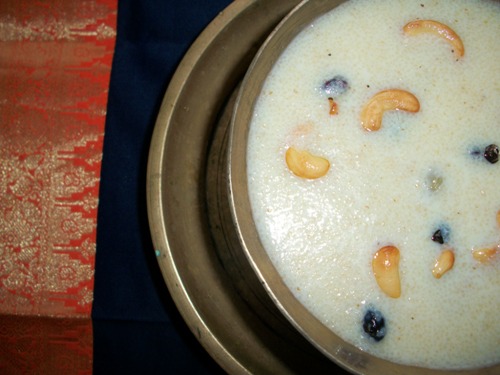

Why This Recipe Works
Timeless Recipe: Rava Payasam is a traditional dish that has stood the test of time, making it a staple in Indian households for generations. Its continued popularity proves its enduring appeal and deliciousness.
Customizable: The recipe is highly adaptable, allowing you to add variations such as coconut milk, saffron, or jaggery depending on personal preference or regional variations.
Quick and Easy: It’s a fast dessert that doesn’t require much preparation or cooking time, making it ideal for quick fixes during festive seasons or regular cravings.
Universal Appeal: The smooth, milky texture and subtle sweetness of Rava Payasam make it appealing to all age groups, from children to adults, ensuring it’s a hit at any gathering.
Sense of Celebration: Rava Payasam brings a sense of celebration and festivity with its rich flavors, instantly making any meal feel like a special occasion. Whether it’s a casual day or a big festival, this dessert transforms any gathering into something memorable.
Perfect End to a Meal: Whether served after a hearty meal or as a standalone treat, Rava Payasam is the perfect sweet ending that leaves you satisfied without feeling too heavy.
Ingredients


Sooji (Semolina): Acts as the main base of the dish, giving it a smooth, hearty texture. It absorbs the milk and flavors beautifully, creating the foundation of this beloved dessert.
Milk: Adds a creamy, rich consistency, making the payasam comforting and indulgent. The milk also helps blend all the flavors together, ensuring a smooth and silky finish.
Sweetened condensed milk: Enhances the sweetness and contributes to the luscious, creamy texture. It gives the payasam its characteristic rich, melt-in-the-mouth quality.
Sugar: Balances the flavor by adding sweetness to the dish. It works harmoniously with the condensed milk, ensuring the payasam is perfectly sweet without being overwhelming.
Cardamom Powder: Brings a fragrant, warm spice that elevates the overall flavor profile.
Cashews: Provide a crunchy texture and a rich, nutty flavor that complements the creamy base.
Raisins: Add sweetness and a chewy texture, offering a contrast to the crunch of cashews.
Ghee: It enhances the flavor with its rich, aromatic essence, giving the payasam a deeper taste and a smooth finish.
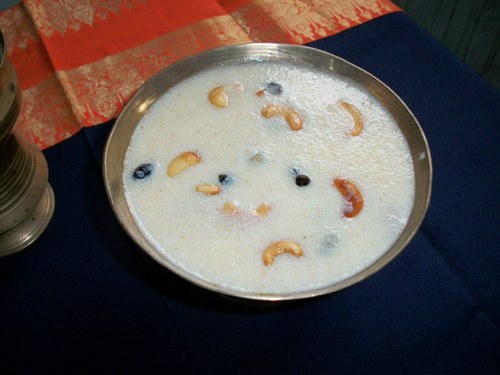

Hacks
- Lightly toast the rava in a dry pan before adding it to the milk. This enhances its flavor and adds a subtle nutty aroma, making your Rava Payasam even more aromatic and flavorful.
- Replace half of the regular milk with coconut milk to give your sooji kheer a rich, creamy texture and a tropical twist, perfect for festive occasions like Onam.
- Soak a few strands of saffron in warm milk and add it to your Rava Payasam for a luxurious golden color and an extra burst of flavor
- For a unique flavor profile, add a pinch of nutmeg along with cardamom. It enhances the warmth of the Rava Payasam, giving it an aromatic depth.
- Instead of using regular sugar, you can replace it with jaggery to give the Rava Payasam a richer, more earthy sweetness, and it adds a slight caramelized flavor.
- To save time, you can make Rava Payasam in a pressure cooker. It speeds up the cooking process, and the payasam still turns out creamy and delicious.
- A small splash of rose water can add an exotic floral note to your Rava Payasam, elevating the flavor to a whole new level of elegance.
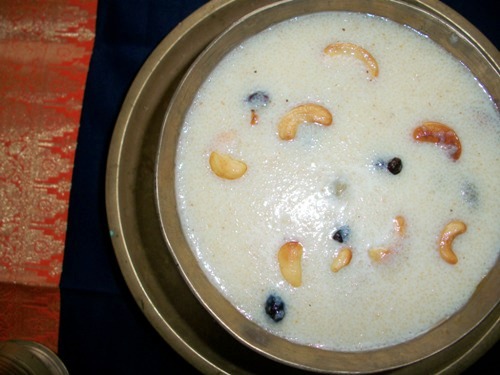

Rava Payasam (Step by Step)
  |
| Take all your ingredients |
  |
| fry cashews and raisins in ghee |
  |
| till it turns golden |
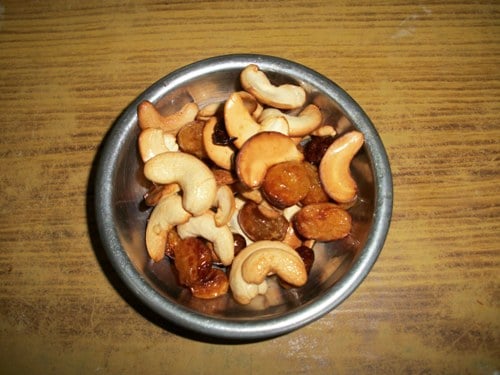  |
| remove and set aside |
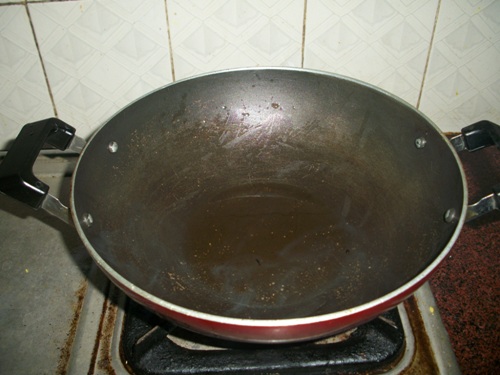  |
| in the remaining ghee |
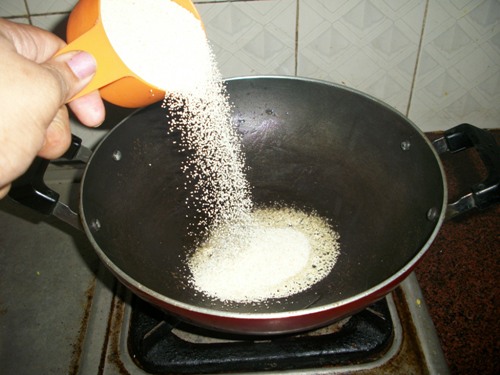  |
| add sooji |
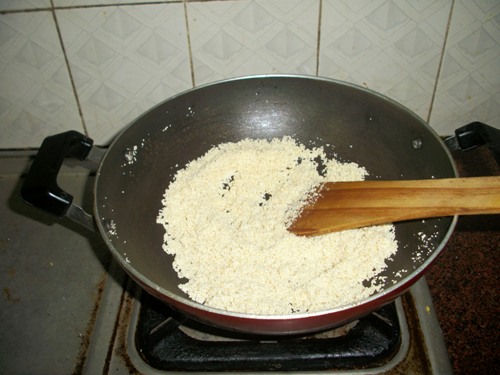  |
| and fry till light golden |
  |
| add milk in this |
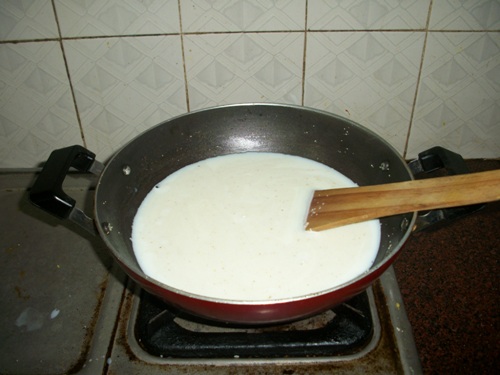  |
| and mix well |
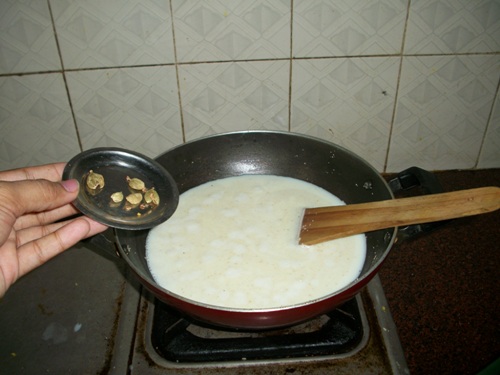  |
| add cardamom in |
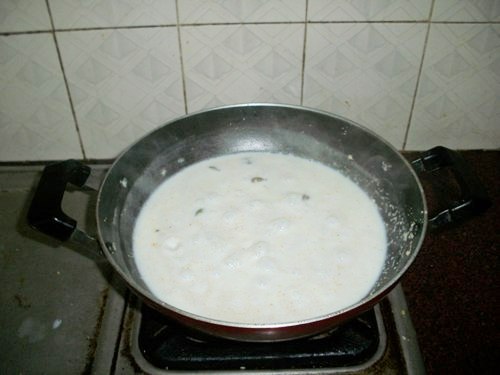  |
| and cook well |
  |
| it will get thicker as it cooks..you can add some more milk and adjust the consistency |
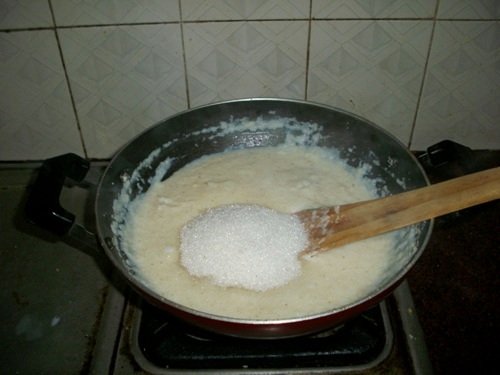  |
| now add sugar in this |
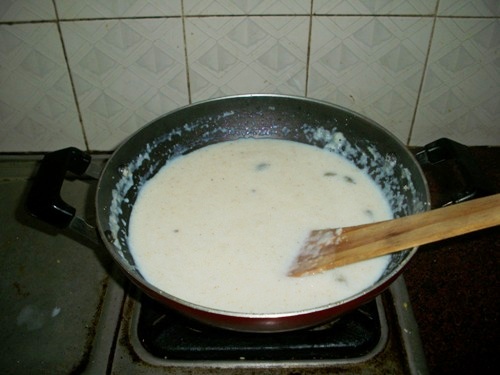  |
| and mix well |
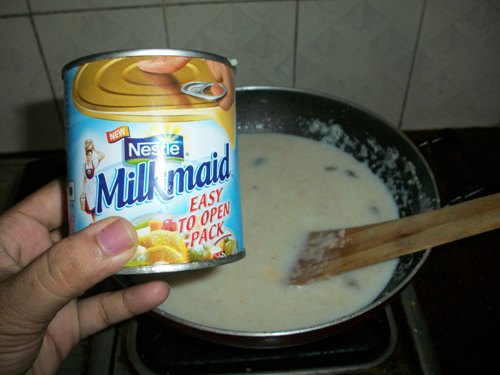  |
| add milkmaid in this |
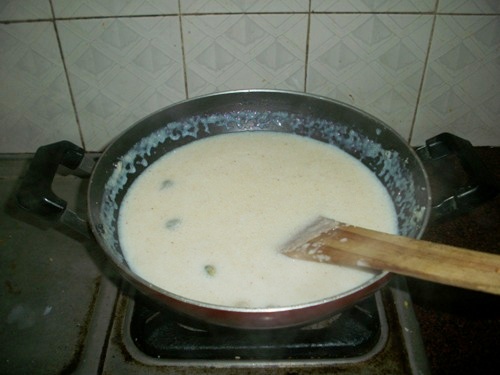  |
| and mix again |
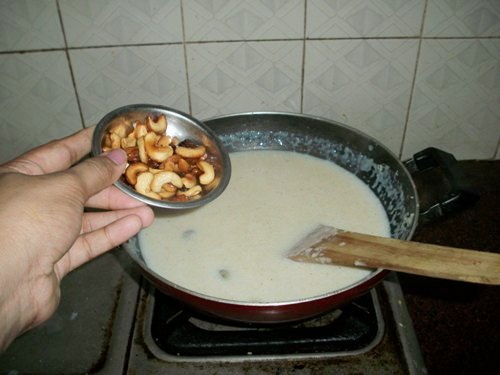  |
| add the roasted nuts back in |
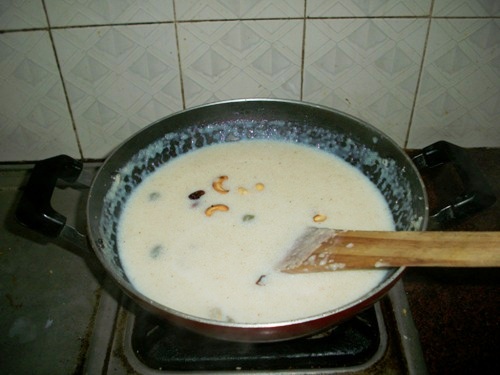  |
| give it a mix |
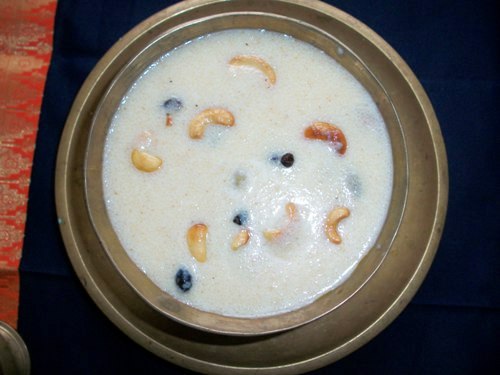  |
| and serve |
Expert Tips
- For the creamiest, richest Rava Payasam, use full-fat milk instead of low-fat. The extra creaminess will make the dessert more indulgent and satisfying.
- After adding milk to the sooji, let it cook on low heat, stirring continuously. This prevents the semolina from clumping together and ensures a smooth, lump-free texture.
- While ghee adds flavor, too much can make the payasam greasy. Stick to the recommended amount and enjoy the balance of richness without overwhelming the dish.
- If the Rava Payasam becomes too thick as it cools, simply add a little warm milk to loosen it to your desired consistency. This ensures the perfect texture, whether you prefer it thick or soupier.
- To add extra flavor, you can use flavored milks like almond milk or cardamom milk for a unique twist on the traditional payasam.
- To make the dessert vegan, use plant-based milk like coconut milk or almond milk, and replace ghee with coconut oil or vegan butter. You can also substitute jaggery for sugar for a healthier alternative.
- During hot months, serve Rava Payasam chilled for a refreshing treat. The smooth, sweet dessert tastes just as good cold, making it a perfect summer dish.
Variations
Wheat Payasam: It is made with broken wheat instead of rava / semolina, Wheat Payasam is a nutritious, hearty dessert. It has a slightly chewy texture and is flavored with cardamom, ghee, and sweeteners like sugar or jaggery, offering a comforting, wholesome taste.
Semiya Payasam: It is a delicious, creamy dessert made using vermicelli (semiya). Often cooked with milk, sugar, and flavored with cardamom, its a classic treat during festivals and celebrations, known for its smooth texture and subtle sweetness.
Nungu Payasam: A refreshing dessert made with nungu (ice apple), Nungu Payasam is perfect for hot summer days. The soft, jelly-like texture of nungu combined with coconut milk and a hint of sweetness makes it a light yet delicious option.
Aval Payasam: Aval Payasam is a simple and quick dessert made with flattened rice (aval), cooked in milk and sweetened with sugar or jaggery. This payasam is delicately flavored with cardamom and garnished with cashews and raisins.
Javarasi Payasam: Made from sago pearls / Javarasi , this payasam has a unique, chewy texture. It’s typically cooked with milk, sugar, and flavored with cardamom, creating a satisfying dessert thats enjoyed during various festivals.
Arisi Thengai Payasam: Arisi Thengai Payasam is made from rice and coconut, offering a traditional flavor that’s rich and satisfying. The combination of rice, freshly grated coconut, and jaggery creates a smooth, flavorful payasam often served at special occasions.
Mango Payasam: Mango Payasam combines the sweetness of ripe mangoes with the richness of milk and sugar. This summer dessert is often flavored with cardamom and served chilled, offering a refreshing tropical twist to the traditional payasam.
Carrot Kheer: Carrot Kheer is a vibrant, nutritious dessert made with grated carrots, milk, and sugar. The carrots are cooked to softness and then mixed with milk and sweeteners, creating a creamy, naturally sweet kheer that’s both delicious and healthy.
FAQ
1. Can I use jaggery instead of sugar for Rava Payasam?
Yes, you can replace sugar with jaggery in Rava Payasam for a healthier, more natural sweetener. It will add a slightly different flavor and color to the dish but will still result in a delicious dessert.
2. Can I make Rava Payasam vegan?
Yes, you can make a vegan Rava Payasam by using plant-based milk like almond milk or coconut milk, and replacing ghee with coconut oil or a vegan butter alternative.
3. How do I prevent Rava from clumping while making Payasam?
To avoid clumping, ensure you stir the rava continuously while cooking and add it gradually to the milk. Cooking on low heat also helps in preventing clumps from forming.
4. Can I prepare Payasam ahead of time?
Yes, you can prepare Payasam a few hours in advance and refrigerate it. Before serving, just reheat it gently and add a little milk to adjust the consistency if needed.
5. Can I make Payasam in a pressure cooker?
Yes, you can make Rava Payasam in a pressure cooker to speed up the cooking process. Just ensure to cook the rava on a low flame to avoid overcooking or burning.
6. How do I adjust the consistency of Rava Payasam?
If your Rava Payasam turns too thick, simply add a little warmer milk to reach the desired consistency. If it’s too thin, let it simmer a bit longer to thicken.
7. Is Rava Payasam healthy?
While Rava Payasam is a delicious treat, it’s best enjoyed in moderation. It contains sooji, milk, and ghee, which are nutritious, but the sugar content can make it calorie-dense. You can adjust the sweetness and use healthier options like jaggery or coconut sugar for a healthier version.
8. Can I freeze Payasam?
It’s not recommended to freeze Rava Payasam as the texture may change when thawed. You can store it in the refrigerator for up to 2 days and reheat before serving.
9. What are the best occasions to serve Payasam?
Payasam is a versatile dessert that’s ideal for festivals like Diwali, Onam, Navratri, and Ugadi. It’s also great for family gatherings, special celebrations, or as a comforting treat after a meal.
More Payasam Recipes to Try
📖 Recipe Card
Rava Payasam Recipe (Sooji Kheer Recipe)
Servings: 6 servings
Calories: 414kcal
Notes
- For the creamiest, richest Rava Payasam, use full-fat milk instead of low-fat. The extra creaminess will make the dessert more indulgent and satisfying.
- After adding milk to the sooji, let it cook on low heat, stirring continuously. This prevents the semolina from clumping together and ensures a smooth, lump-free texture.
- While ghee adds flavor, too much can make the payasam greasy. Stick to the recommended amount and enjoy the balance of richness without overwhelming the dish.
- If the Rava Payasam becomes too thick as it cools, simply add a little warm milk to loosen it to your desired consistency. This ensures the perfect texture, whether you prefer it thick or soupier.
- To add extra flavor, you can use flavored milks like almond milk or cardamom milk for a unique twist on the traditional payasam.
- To make the dessert vegan, use plant-based milk like coconut milk or almond milk, and replace ghee with coconut oil or vegan butter. You can also substitute jaggery for sugar for a healthier alternative.
- During hot months, serve Rava Payasam chilled for a refreshing treat. The smooth, sweet dessert tastes just as good cold, making it a perfect summer dish.
Nutrition
Serving: 1servings | Calories: 414kcal | Carbohydrates: 62g | Protein: 9g | Fat: 16g | Saturated Fat: 9g | Polyunsaturated Fat: 1g | Monounsaturated Fat: 4g | Cholesterol: 43mg | Sodium: 80mg | Potassium: 388mg | Fiber: 1g | Sugar: 47g | Vitamin A: 305IU | Vitamin C: 1mg | Calcium: 246mg | Iron: 1mg
If you have any questions not covered in this post and if you need help, leave me a comment or mail me @[email protected] and I’ll help as soon as I can.
Follow me on Instagram, Facebook,Pinterest ,Youtube and Twitter for more Yummy Tummy inspiration.
IF YOU MAKE THIS RECIPE OR ANYTHING FROM YUMMY TUMMY, MAKE SURE TO POST IT AND TAG ME SO I CAN SEE ALL OF YOUR CREATIONS!! #YUMMYTUMMYAARTHI AND @YUMMYTUMMYAARTHI ON INSTAGRAM!
More Sweet Recipes to Try
Reader Interactions

Source link
